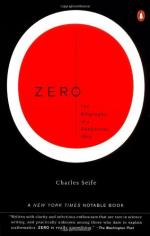|
This section contains 643 words (approx. 2 pages at 400 words per page) |

|
Chapter 3, Nothing Ventured Summary and Analysis
Indians and Arabs welcomed zero. Indian mathematicians first learned of zero from the Babylonians by way of Greek conquest. India was insulated from the rise of Christian and Aristotle's philosophy. India never feared the void and it had a key place within Hinduism. Hinduism was initially a polytheistic religion. Over time, the gods of Hinduism began to merge and Hinduism became a monotheistic faith. Like other Eastern faiths, Hinduism was steeped in duality. The god Shiva was both creator and destroyer and also represented nothingness. Shiva was the ultimate void or the incarnation of lifelessness. The Hindu universe is full of many other worlds but the cosmos still has a sort of emptiness. The world came from nothingness and achieving nothingness is the goal of man. This meant the elimination of self. Liberation from the cycle of...
(read more from the Chapter 3, Nothing Ventured Summary)
|
This section contains 643 words (approx. 2 pages at 400 words per page) |

|




